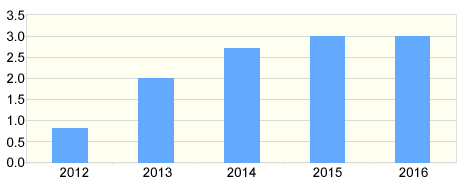
We’re only a couple of months into the new financial year, yet the latest figures in government borrowing suggest that the public finances are already set to be worse than expected this year.
This shouldn’t be a huge surprise. The UK economy is back in recession, tax receipts are weaker and government spending remains too high.
This looks like the start of a trend; a trend that will have big implications not only for your savings but for how you save for the future.
Let me explain.
The trouble is that the government’s deficit reduction plan lacks credibility. It is based on ‘pie in the sky’ forecasts that the economy will start roaring ahead again.
We’re in recession now. Yet the Office for Budget Responsibility (OBR) thinks that by 2015, the economy will be growing at 3% per year (adjusted for inflation – see chart below), or just over 5% in nominal terms.
OBR real GDP growth forecasts (%)
This looks like wishful thinking to me.
Apparently, the growth will be driven by people spending more. But how are people who are already finding it hard to make ends meet, going to find the money to spend even more?
The OBR also assumes that people will run down their savings too. Yet lots of people actually need to save more and pay off debt, not deplete their savings further.
Businesses are unlikely to come to the rescue. Levels of business investment remain low. Despite having very healthy finances, many firms just don’t see enough projects where they can get good returns.
The outlook for exports isn’t brilliant either. Many overseas customers are facing their own problems, which means they probably won’t be buying more of what we sell.
To me, this means that the current forecasts to eliminate most of the deficit (the annual overspend) by 2016-17 look fanciful. Yet assuming that tax receipts will be just over 36% of money GDP, the OBR predicts that this will nearly happen.
| Year | Tax receipts (£bn) | Spending (£bn) | Deficit (£bn) | Extra debt (£bn) |
|---|---|---|---|---|
| 2011-12 | 570.4 | 696.4 | -126 | -126 |
| 2012-13 | 591.5 | 683.4 | -91.9 | -217.9 |
| 2013-14 | 622.5 | 720 | -97.5 | -315.4 |
| 2014-15 | 658.4 | 733.5 | -75.1 | -390.5 |
| 2015-16 | 692 | 744 | -52 | -442.5 |
| 2016-17 | 735.3 | 756.3 | -21 | -463.5 |
But if GDP fails to meet forecasts – as I think it will – then tax receipts are going to be lower than the Treasury currently expects. Another thing to highlight here is that government spending isn’t going down, it’s going up. We could be left with an even bigger mess than we are now.
Taxes will have to go up
All the talk of cutting government spending is clearly nonsense. A rising debt interest bill and high welfare payments are offsetting cuts made in government departments.
The government is stuck in a rut. The state’s contribution to the economy is just too big at nearly 50%. But while slashing the size of the state is the right thing to do for our long-term wellbeing, it just makes the economy worse in the short term.
Unlike in the 1990s, when the Tory government balanced tax rises and spending cuts to get the public finances back in shape, the current plan is based more on cuts. This will have to change. Taxes are going to have to go up too.
This seems like madness. The economy needs tax rises like a hole in the head. They will suck demand out of the economy, as people will have less disposable income to spend. This is true, and just highlights the mess we are in. It also tells you why the Bank of England is printing money and may have to print a lot more.
Go for Isas instead of pensions
The bleak economic outlook probably means that investment returns are unlikely to be good. You have to wonder how long the bond markets will lend to us for ten years at 1.7%? A bond market crash remains the biggest threat to our wealth, but that’s a story for another day.
If taxes have to go up to raise more income for the government, then it may erode the attractions of personal pensions. The generous tax relief for higher rate taxpayers could well be unsustainable. It represents an easy gain for a government looking for cash.
But there’s a more serious issue to consider. While you’ve been given tax relief on your pension contributions, the income in retirement has been subject to income tax.
If you are 10, 20, or even 30 years from retirement, you’ve got to wonder whether the tax you will pay on your retirement income then will be set at a higher rate than most pensioners pay now.
And if you think this might happen, then it makes sense to put more of your retirement savings in an Isa. Why? Because although you don’t get any tax relief on the money you put in, the money you take out is tax-free. So whatever happens to income taxes between now and when you retire, your money will be shielded.
The Isa allowance is now quite generous. Let’s hope that governments don’t start meddling with that too. But a couple can now save £22,560 (£11,280 each) between them each year with allowances increasing by Consumer Price Index inflation each year. That should allow most people to have a chance of building a decent retirement fund.
We’ve liked the simplicity of Isas at MoneyWeek for sometime now (you can read more about why here: Pensions vs Isas: what’s the best way to save for retirement?). The prospect of higher tax rates in the future is just another reason to like them.